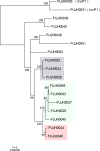Clinical and genomic characteristics of IMP-producing Enterobacter cloacae complex and Klebsiella pneumoniae
- PMID: 38517188
- PMCID: PMC11064536
- DOI: 10.1128/aac.01672-23
Clinical and genomic characteristics of IMP-producing Enterobacter cloacae complex and Klebsiella pneumoniae
Abstract
Carbapenemase-producing Enterobacterales (CPEs) are one of the top priority antimicrobial-resistant pathogens. Among CPEs, those producing acquired metallo-β-lactamases (MBLs) are considered particularly problematic as few agents are active against them. Imipenemase (IMP) is the most frequently encountered acquired MBL in Japan, but comprehensive assessment of clinical and microbiological features of IMP-producing Enterobacterales infection remains scarce. Here, we retrospectively evaluated 62 patients who were hospitalized at a university hospital in Japan and had IMP-producing Enterobacterales from a clinical culture. The isolates were either Enterobacter cloacae complex or Klebsiella pneumoniae, and most of them were isolated from sputum. The majority of K. pneumoniae, but not E. cloacae complex isolates, were susceptible to aztreonam. Sequence type (ST) 78 and ST517 were prevalent for E. cloacae complex and K. pneumoniae, respectively, and all isolates carried blaIMP-1. Twenty-four of the patients were deemed infected with IMP-producing Enterobacterales. Among the infected patients, therapy varied and largely consisted of conventional β-lactam agents, fluoroquinolones, or combinations. Three (13%), five (21%), and nine (38%) of them died by days 14, 30, and 90, respectively. While incremental mortality over 90 days was observed in association with underlying comorbidities, active conventional treatment options were available for most patients with IMP-producing Enterobacterales infections, distinguishing them from more multidrug-resistant CPE infections associated with globally common MBLs, such as New Delhi metallo-β-lactamase (NDM) and Verona integron-encoded metallo-β-lactamase (VIM).
Keywords: carbapenemase-producing Enterobacterales; clinical outcome; genome epidemiology; metallo-beta-lactamase.
Conflict of interest statement
The authors declare no conflict of interest.
Figures



References
-
- Guh AY, Bulens SN, Mu Y, Jacob JT, Reno J, Scott J, Wilson LE, Vaeth E, Lynfield R, Shaw KM, Vagnone PMS, Bamberg WM, Janelle SJ, Dumyati G, Concannon C, Beldavs Z, Cunningham M, Cassidy PM, Phipps EC, Kenslow N, Travis T, Lonsway D, Rasheed JK, Limbago BM, Kallen AJ. 2015. Epidemiology of carbapenem-resistant Enterobacteriaceae in 7 US communities. JAMA 314:1479–1487. doi: 10.1001/jama.2015.12480 - DOI - PMC - PubMed
-
- Cantón R, Akóva M, Carmeli Y, Giske CG, Glupczynski Y, Gniadkowski M, Livermore DM, Miriagou V, Naas T, Rossolini GM, Samuelsen Ø, Seifert H, Woodford N, Nordmann P, European Network on Carbapenemases . 2012. Rapid evolution and spread of carbapenemases among Enterobacteriaceae in Europe. Clin Microbiol Infect 18:413–431. doi: 10.1111/j.1469-0691.2012.03821.x - DOI - PubMed
-
- Osano E, Arakawa Y, Wacharotayankun R, Ohta M, Horii T, Ito H, Yoshimura F, Kato N. 1994. Molecular characterization of an enterobacterial metallo β-lactamase found in a clinical isolate of Serratia marcescens that shows imipenem resistance. Antimicrob Agents Chemother 38:71–78. doi: 10.1128/AAC.38.1.71 - DOI - PMC - PubMed
Publication types
MeSH terms
Substances
Grants and funding
LinkOut - more resources
Full Text Sources
Medical
Research Materials
Miscellaneous

